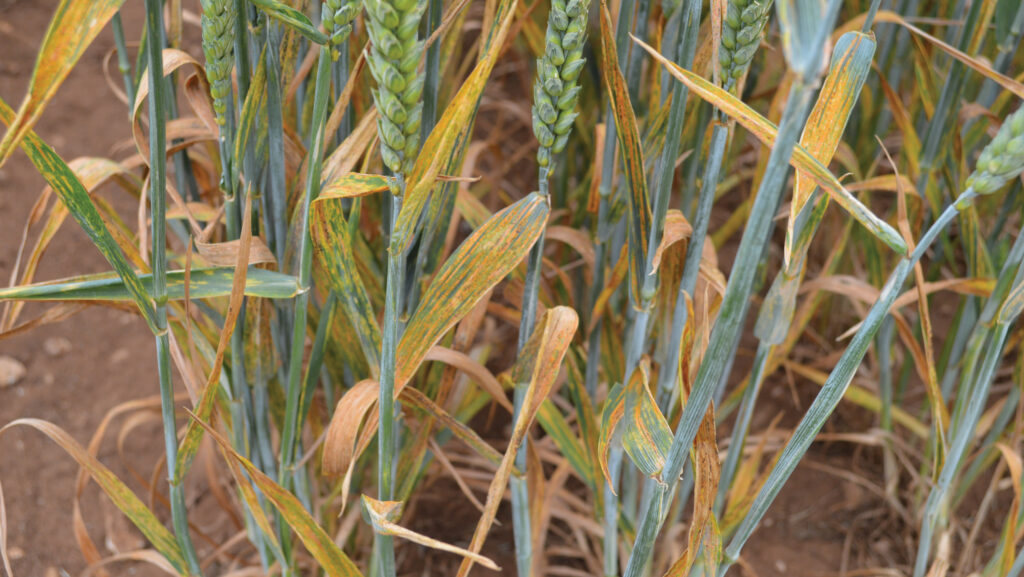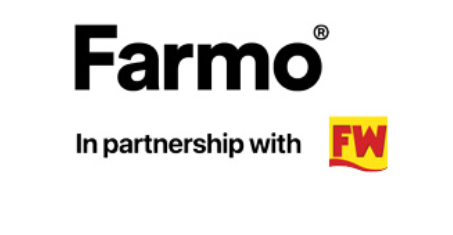Wheat yellow rust ratings set to fall for next season
 Yellow rust in plots at Cereals 2025 © MAG/David Jones
Yellow rust in plots at Cereals 2025 © MAG/David Jones Winter wheat growers are being warned that disease resistance ratings for yellow rust are set to fall this summer for many leading feed wheat varieties, after a new race of the disease has overcome a key Yr15 resistance gene.
Many popular hard-milling feed wheat varieties, such as Dawsum, Champion, Typhoon and Beowulf, have shown increased levels of yellow rust this season as they include the Yr15 gene.
Consequently, they are likely to see their ratings reduced in August.
See also: Why Essex grower is expanding Scope wheat area this autumn
At least 60% of the winter wheat in the ground currently has the Yr15 gene, so it is likely that this high percentage put the gene under pressure.
Rating changes
The result is that growers will need to be on the alert for the disease next season, and this is prompting some to argue for a return to older, more-trusted varieties.
Niab senior specialist in crop protection Aoife O’Driscoll says yellow rust resistance ratings are set to drop, and growers need to note the rating changes and manage their crops accordingly.
“The ratings will fall and is it likely that Dawsum and Champion will drop to a 4/5/6. Therefore, growers need to get in early and get control of yellow rust,” she says.
Three of the affected varieties, Dawsum, Typhoon and Beowulf, currently score a maximum 9, and Champion a 8 for yellow rust resistance in a 1-9 AHDB Recommended List (RL) scoring system, where 1 is very susceptible and 9 shows good resistance.
All these varieties were resistant to yellow rust at the young plant stage.
These rating changes are likely to be made when all the data on the new race or a mutant race of yellow rust is examined.
They are set to be available to growers in August, say crop experts.
There will be three-year and one-year scores for yellow rust resistance to reflect the greater incidence of the disease this season.
Resistance breakdown incidence
Although the Yr15 resistance breakdown was largely localised to the East Coast from Scotland to The Wash, and was first spotted on an RL trial site near Sunderland in March, the effect is set to be more widespread next year.
The incidence was made worse as a big chunk of the winter wheat crop was drilled late in November, after a very wet late September and October, and yellow rust is encouraged by late drilling.
This is the opposite to septoria, where late drilling helps with control.
Patrick Stephenson, a Niab regional agronomist based in Yorkshire, says that yellow rust was seen in virtually every variety in trials this year, showing a big yellow rust pressure and some varieties were very dependent on the Yr15 gene.
He was picking up yellow rust along the Yorkshire coast in March on varieties with resistance ratings of 8 and 9 before the disease started to spread more inland.
Older varieties
Patrick says some of his growers will stick with affected varieties such as Dawsum and Champion as they know them.
But others may switch back to older, more-trusted ones such as Graham and Gleam.
Although these two have lower historic yellow rust scores – Graham scores a 7 and Gleam just a 5 – both are susceptible to young plant resistance.
Patrick says these older varieties may help to de-risk the yellow rust situation next spring.
However, many growers will be drilling the more susceptible varieties as that is where the bulk of the feed wheat seed will be for the autumn, so growers will need to plan.
“Growers will have to drill some of these varieties – and when they do, they need to make sure they can get to those areas quickly with a spray if needed,” he says.
“There was only six weeks between T0 and T3 this year and every day was a spray day, but it might not be the same next year, “ he adds.
Newer varieties
Of the newer varieties, the highest yielding RL variety Scope was affected by yellow rust this season, but not as badly as Champion and Dawsum, and there will be seed available of this newly recommended feed wheat variety this autumn.
Among the candidates varieties coming up for recommendation later this year, Patrick says Defiance looks generally clean of yellow rust, while Fowlmere only has some limited yellow rust.
Patrick does warn that if growers are tempted to drill wheat early after the frustration of the wet autumn of 2024, they should be aware of the risk of septoria.
Taking one variety such as Dawsum, its moderate-to-good septoria rating of 6.3 could fall by one full percentage point if drilled early in September compared to later in October, and this is applies to all other varieties.
Treatment options
Fortunately with yellow rust, fungicide treatment does tend to be cheaper and more effective than for septoria, although growers will need to be extra vigilant in the early spring concerning a T0 spray or even a pre-T0 treatment.
Aoife advises using the azole tebuconazole plus a strobilurin as a T0 treatment if growers see yellow rust in the spring.
The tebuconazole will give quick knock down of the disease, while the strobilurin will give a more persistence effect.
Strobilurins such as pyraclostrobin (Comet) and azoxystrobin (Amistar) can only be used in a mixture, hence tebuconazole would be a good partner.
Grower experience
David Jones, farm manager at Morley Farms, near Wymondham, Norfolk, grows 140ha of winter wheat, largely of the newly susceptible yellow rust varieties Dawsum and Beowulf.
He did not see much yellow rust in a cold and dry spring, and hence missed out on a T0 spray.
Next season, he will stick with these two varieties – Dawsum has proved very reliable on the farm over the past few years, and Beowulf has looked good throughout the season.
“Next year, if the weather is milder and wetter, we will be more vigilant and be looking out for the disease,” he says.
Popular hard-milling feed winter wheat varieties |
|||||||
| Scope | Dawsum | Champion | Beowulf | Typhoon | Graham | Gleam | |
| Fungicide-treated yield (%) | 108 | 103 | 107 | 105 | 101 | 103 | 103 |
| Untreated yield (%) | 85 | 89 | 86 | 85 | 87 | 86 | 78 |
| Disease resistance | |||||||
| Yellow rust | 7 | 9 | 8 | 9 | 9 | 7 | 5 |
| Brown rust | 6 | 7 | 5 | 4 | 6 | 5 | 6 |
| Septoria tritici | 6.5 | 6.3 | 7.6 | 6.6 | 7.2 | 6.5 | 5.7 |
| Agronomic features | |||||||
| Resistance to lodging (no plant growth regulator) | 8 | 8 | 7 | 8 | 7 | 7 | 7 |
| Ripening (days +/-Skyfall) | +1 | +1 | 0 | +2 | +2 | -1 | 0 |
| Specific weight (kg/hl) | 78.9 | 79.9 | 75.6 | 78.5 | 77.4 | 77.8 | 77.1 |
All those speaking to Farmers Weekly were attending a recent Morley Innovation Day at The Morley Agricultural Foundation, a charity which operates Morley Farms, near Wymondham, in Norfolk.
The farm, which is also the AHDB Strategic Cereal Farm East, consists of 700ha of arable cropping on light sandy loam soil.

